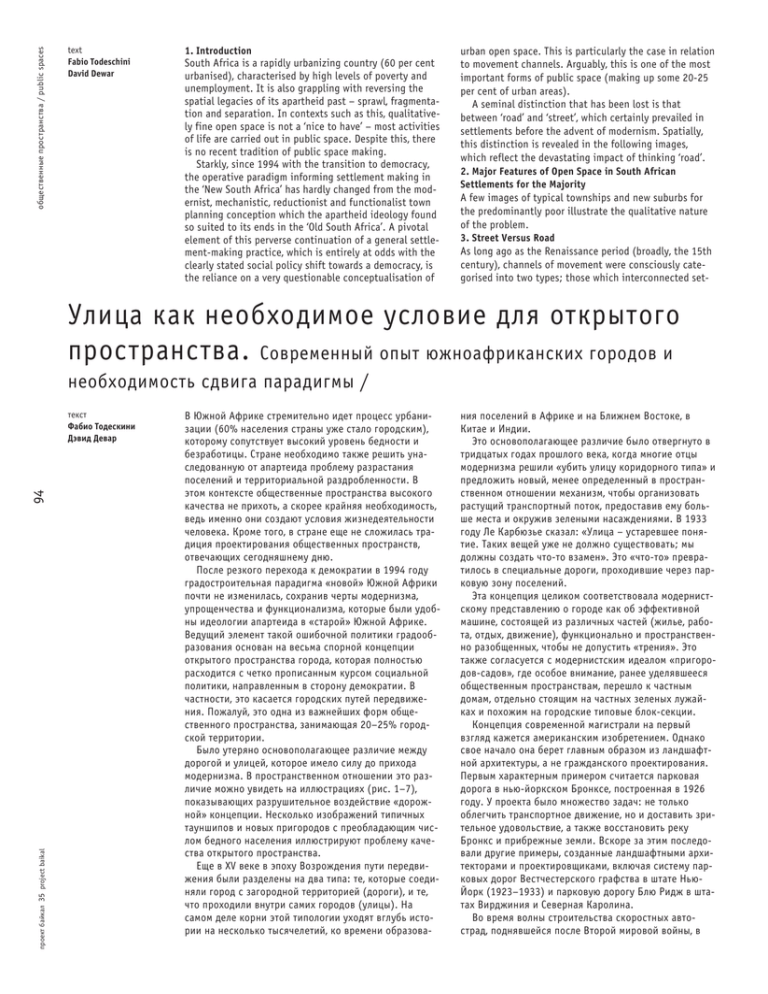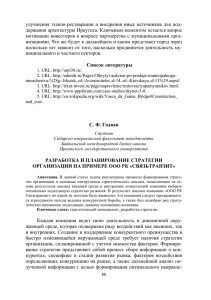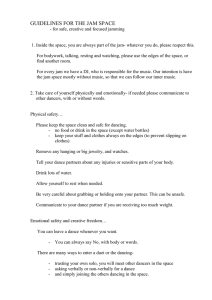Улица как необходимое условие для открытого
реклама

общественные пространства / public spaces text Fabio Todeschini David Dewar 1. Introduction South Africa is a rapidly urbanizing country (60 per cent urbanised), characterised by high levels of poverty and unemployment. It is also grappling with reversing the spatial legacies of its apartheid past – sprawl, fragmentation and separation. In contexts such as this, qualitatively fine open space is not a ‘nice to have’ – most activities of life are carried out in public space. Despite this, there is no recent tradition of public space making. Starkly, since 1994 with the transition to democracy, the operative paradigm informing settlement making in the ‘New South Africa’ has hardly changed from the modernist, mechanistic, reductionist and functionalist town planning conception which the apartheid ideology found so suited to its ends in the ‘Old South Africa’. A pivotal element of this perverse continuation of a general settlement-making practice, which is entirely at odds with the clearly stated social policy shift towards a democracy, is the reliance on a very questionable conceptualisation of urban open space. This is particularly the case in relation to movement channels. Arguably, this is one of the most important forms of public space (making up some 20-25 per cent of urban areas). A seminal distinction that has been lost is that between ‘road’ and ‘street’, which certainly prevailed in settlements before the advent of modernism. Spatially, this distinction is revealed in the following images, which reflect the devastating impact of thinking ‘road’. 2. Major Features of Open Space in South African Settlements for the Majority A few images of typical townships and new suburbs for the predominantly poor illustrate the qualitative nature of the problem. 3. Street Versus Road As long ago as the Renaissance period (broadly, the 15th century), channels of movement were consciously categorised into two types; those which interconnected set- Улица как необходимое условие для открытого пространства. Современный опыт южноафриканских городов и необходимость сдвига парадигмы / проект байкал 35 project baikal 94 текст Фабио Тодескини Дэвид Девар В Южной Африке стремительно идет процесс урбанизации (60% населения страны уже стало городским), которому сопутствует высокий уровень бедности и безработицы. Стране необходимо также решить унаследованную от апартеида проблему разрастания поселений и территориальной раздробленности. В этом контексте общественные пространства высокого качества не прихоть, а скорее крайняя необходимость, ведь именно они создают условия жизнедеятельности человека. Кроме того, в стране еще не сложилась традиция проектирования общественных пространств, отвечающих сегодняшнему дню. После резкого перехода к демократии в 1994 году градостроительная парадигма «новой» Южной Африки почти не изменилась, сохранив черты модернизма, упрощенчества и функционализма, которые были удобны идеологии апартеида в «старой» Южной Африке. Ведущий элемент такой ошибочной политики градообразования основан на весьма спорной концепции открытого пространства города, которая полностью расходится с четко прописанным курсом социальной политики, направленным в сторону демократии. В частности, это касается городских путей передвижения. Пожалуй, это одна из важнейших форм общественного пространства, занимающая 20–25% городской территории. Было утеряно основополагающее различие между дорогой и улицей, которое имело силу до прихода модернизма. В пространственном отношении это различие можно увидеть на иллюстрациях (рис. 1–7), показывающих разрушительное воздействие «дорожной» концепции. Несколько изображений типичных тауншипов и новых пригородов с преобладающим числом бедного населения иллюстрируют проблему качества открытого пространства. Еще в XV веке в эпоху Возрождения пути передвижения были разделены на два типа: те, которые соединяли город с загородной территорией (дороги), и те, что проходили внутри самих городов (улицы). На самом деле корни этой типологии уходят вглубь истории на несколько тысячелетий, ко времени образова- ния поселений в Африке и на Ближнем Востоке, в Китае и Индии. Это основополагающее различие было отвергнуто в тридцатых годах прошлого века, когда многие отцы модернизма решили «убить улицу коридорного типа» и предложить новый, менее определенный в пространственном отношении механизм, чтобы организовать растущий транспортный поток, предоставив ему больше места и окружив зелеными насаждениями. В 1933 году Ле Карбюзье сказал: «Улица – устаревшее понятие. Таких вещей уже не должно существовать; мы должны создать что-то взамен». Это «что-то» превратилось в специальные дороги, проходившие через парковую зону поселений. Эта концепция целиком соответствовала модернистскому представлению о городе как об эффективной машине, состоящей из различных частей (жилье, работа, отдых, движение), функционально и пространственно разобщенных, чтобы не допустить «трения». Это также согласуется с модернистским идеалом «пригородов-садов», где особое внимание, ранее уделявшееся общественным пространствам, перешло к частным домам, отдельно стоящим на частных зеленых лужайках и похожим на городские типовые блок-секции. Концепция современной магистрали на первый взгляд кажется американским изобретением. Однако свое начало она берет главным образом из ландшафтной архитектуры, а не гражданского проектирования. Первым характерным примером считается парковая дорога в нью-йоркском Бронксе, построенная в 1926 году. У проекта было множество задач: не только облегчить транспортное движение, но и доставить зрительное удовольствие, а также восстановить реку Бронкс и прибрежные земли. Вскоре за этим последовали другие примеры, созданные ландшафтными архитекторами и проектировщиками, включая систему парковых дорог Вестчестерского графства в штате НьюЙорк (1923–1933) и парковую дорогу Блю Ридж в штатах Вирджиния и Северная Каролина. Во время волны строительства скоростных автострад, поднявшейся после Второй мировой войны, в prising individual parts (residing, working, recreating, moving), separated functionally and spatially to prevent ‘friction’. It is also consistent with the modernist ideal of the ‘garden suburb’, with the historical emphasis on public space being replaced by individual buildings freestanding in private green space as the basic building blocks of urban settlements. The concept of the modern highway was, in the first instance, an American invention. Significantly, however, its origins lay in landscape architecture, not civil engineering. The first notable example was the attractive Bronx City Parkway in New York (completed in 1926). The purposes of the project were multiple; certainly to achieve the transportation objective of facilitating traffic movement but also to provide a gratifying visual experience and to rehabilitate the Bronx River and riparian lands (McHarg, 1996:103). Other examples undertaken by landscape architects and planners, which followed общественные пространства / public spaces tlements with the countryside (road), and those internal to the settlements themselves (streets). Indeed, this typology has deep historical roots which revert back to the earliest days of settlementformation, thousands of years ago, in Africa and the Near East, as well as in China and India. This essential distinction was consciously subverted in the 1930s when many of the fathers of modernism sought to ‘kill the corridor street’ and promote some new, far greener, larger and less spatially defined mechanism to accommodate (increasingly vehicular) movement. Thus, Le Corbusier wrote in 1933, “Streets are an obsolete notion. There ought not to be such a thing as streets; we have to create something to replace them” (Le Corbusier, 1933). This “something” was specialist movement channels moving through parkland within settlements. This concept was entirely consistent with the modernist notion of the city as an efficient machine, com- The Street as Pre-requisite Open Space Current South African Settlement Practice and the Need for a Paradigm Shift США ощущалась нехватка ландшафтных архитекторов (в стране было мало практикующих специалистов), в связи с чем эта должность все чаще замещалась инженерами-дорожниками – лидерами данной отрасли. Когда наступил период упрощенчества, «парковая» составляющая постепенно исчезла из концепции «городского движения в парковой зоне» (в основном по причине капитальных и эксплуатационных затрат), и на ее место пришла политика, продиктованная инже- нерами, которая проявлялась, например, в расширении придорожных зон. Более того, этот настрой специалистов на создание «дорог» все больше сказывался не только на важнейших протяженных транспортных путях, но и на всех уровнях, включая местные полосы отвода. Согласно этой политике, здания теперь отодвинуты за пределы улицы и отделены от нее заборами или стенами, обозначающими кадастровые границы. В условиях понятийной нечеткости необходимо проект байкал 35 project baikal < Figures 1–3. Aerial views of Mitchells Plain and Kayelitsha, Cape Town, South Africa / Рис. 1–3. Аэроснимки равнины Митчелла и района Хайелитша, Кейптаун (ЮАР) общественные пространства / public spaces are set back from street frontages with fences and/or walls demarcating cadastral boundaries. Given this conceptual blurring, it is necessary to redefine this essential distinction between ‘street’ and ‘road’. In essence, the distinction lies in the concept of multi-functionality. In the case of streets, the movement channels are in the first instance seen as public spaces that need to accommodate a variety of human activities, of which movement is one. Functionally, the role of the street is inextricably intertwined with the activities that flank it, and the primary role of the structures which accommodate those activities is to give definition and enclosure to the public space. Clearly, therefore, different streets have different functions and different emphases of functions (for example, ranging from an emphasis on movement on important arterials to an emphasis on social and play space in the case of very local streets) and they need to be designed accordingly. As stated, as a заново определить, в чем состоит принципиальное различие между «улицей» и «дорогой». В основе его лежит идея многофункциональности. Что касается улиц, здесь пути передвижения в первую очередь рассматриваются как общественные пространства, предназначенные для различных видов деятельности человека, один из которых – движение. С точки зрения функциональности, роль улицы неразрывно связана с той деятельностью, которая осуществляется у границ этой улицы, а сооружения, предназначенные для этой деятельности, должны в первую очередь определять и огораживать данное общественное пространство. Очевидно, что разные улицы имеют разные функции и функциональные акценты (например, начиная с акцента на движении на главных городских артериях и заканчивая акцентом на социальной и игровой функции внутренних улиц). Все это должно учитываться при проектировании улиц. При этом главный принцип гласит: чем больше интенсивность деятельности и разнообразие ее видов в пределах одной улицы, тем сложнее должен быть профиль этой улицы. «Дороги» же главным образом монофункциональны. Это каналы, специально предназначенные для транспортного движения, и их эффективность измеряется в большей степени с точки зрения безопасности и инженерных показателей, нежели социальных и экологических критериев. Акцент делается на оптимальном решении единственной задачи – движения. Одновременно с упрощением значения улицы до значения дороги происходила замена пространства общественного на парковочное. Все больше общественных пространств специально создаются для размещения транспортных средств, в отличие от многофункциональных общественных мест, где парковка возможна только в определенные часы. Например, ориентированные на внутреннее пространство торговые центры – храмы современности – стоят в окружении огромного количества машин. Такие места, переполненные автомобилями или пустующие, имеют крайне негативные последствия для окружающей среды. Зачастую их можно сравнить с опасными и неприятными мусорными свалками. Во всем мире все больше специалистов приходят к выводу, что для улучшения качества пространств и социальной политики в городах необходимо вернуться к проектированию улиц и общественных пространств, противопоставив их дорогам и парковочным местам (например, Shane, 1972 и 1982; Appleyard, 1981; Rapoport, 1983, 1990 и 1993; Anderson, 1986; Trancik, 1986; Moudon-Vernez, 1987; Gehl, 1987; Moughtin, 1991 и 1992; Jacobs, 1993; McHarg, 1996, а также Gehl и Gemzoe, 2001). Воплощая эту идею, важно осознавать, что идеальные условия для отдельно взятого вида деятельности создать невозможно, однако целостный подход может достичь большего успеха. Главной градостроительной задачей считается оптимизация функционирования города в целом, а не отдельных его частей. Такая оптимизация в условиях совмещения и выбора нужных элементов является отличительной чертой всех успешно функционирующих городов. При этом нельзя отрицать важность проработки профес- 96 soon afterwards, included the creation of the Westchester County (New York) Parkway System (1923-1933) and the Blue Ridge Parkway in Virginia and North Carolina. In the spate of freeway building following the Second World War, the capacity of the landscape architectural profession in the USA (there were few practitioners in the country) was exhausted (McHarg, 1996) and increasingly the landscape architect was replaced by the highway engineer as the champion of the freeway movement. With the period of reductionism that followed, the ‘parkland’ dimension of this idea of ‘urban movement in parkland’ gradually disappeared (often for reasons of capital or maintenance cost) and was replaced by engineering dictates, such as the provision of extensive road reserves. Moreover, this mindset of specialist ‘roads’ increasingly applied not only to lengthy, more important movement channels, but to all scales of movement, right down to the local right-of-way. In terms of this model, buildings проект байкал 35 project baikal ^ Figure 4. Kayelitsha, Cape Town, South Africa / Рис. 4. Хайелитша, Кейптаун (ЮАР) > Figures 5–6. Delft, Cape Town, South Africa. Examples of the inhospitable and highly inconvenient urban space in which many urban poor live / Рис. 5–6. Дельфт, Кейптаун (ЮАР). Примеры негостеприимного и крайне некомфортного городского пространства, в котором живут многочисленные представители бедного населения общественные пространства / public spaces 97 сиональных, специфических или «технических» вопросов (например, касающихся безопасности транспортных средств и т. д.). Они должны быть включены в проектирование, но в более широких рамках. Ведь зачастую для улучшения общей ситуации требуется разумный компромисс. Открытое пространство нельзя рассматривать как самоцель. Это всего лишь один, хотя и очень важный элемент общественной структуры города (главные составляющие общественной структуры – это зеленые пространства, движение, общественные пространства, социальные учреждения, коммунальные и аварийноспасательные службы) (рис. 8). Таким образом, городское открытое пространство практически не может иметь внутренние правила или предписания, которые бы по важности превосходили общегородские требования. Скорее эти требования должны быть ориентиром для открытого пространства. Главная задача заключается в определении его потенциальной роли в рамках общей реструктуризации южноафриканских городов. Необходимо создать благоприятные условия для развития улицы как многофункционального пространства, особенно в контексте стремительной урбанизации. Для этого в городском планировании должен произойти сдвиг парадигмы, поскольку понятие «дорога» все еще часто заменяет понятие «улица». Итак, можно сделать следующие выводы. Открытое пространство не должно рассматриваться как самоцель. Это всего лишь один, хотя и очень важный, элемент общественной структуры города. Поэтому городское открытое пространство не может иметь внутренние правила или предписания, которые бы по важности превосходили общегородские требования. Именно общегородские требования должны ориентировать открытое пространство на более урбанистическую модель. Важно определить потенциальную роль разных типов открытого пространства в рамках общей реструктуризации южноафриканских городов, нацеленной на принципы справедливости и эффективности, а также на поддержку тактики выживания неимущего большинства населения. Улица – это многофунк- drals – for example, stand surrounded in a sea of cars. The environmental consequences of these spaces, both when they are filled with vehicles and when they are empty are extremely negative. They are often little more than dangerous and unpleasant dumping grounds for rubbish. It is being increasingly recognized internationally that significant improvements to the spatial quality and social performance of urban settlements demand a return to the design of streets and public spaces as opposed to roads and parking lots (for example: Shane, 1972 and 1982; Appleyard, 1981; Rapoport, 1983, 1990 and 1993; Anderson, 1986; Trancik, 1986; Moudon-Vernez, 1987; Gehl, 1987; Moughtin, 1991 and 1992; Jacobs, 1993; McHarg, 1996, and Gehl and Gemzoe, 2001). In this endeavour, it is important to recognize that no one activity will be accommodated ideally; the whole, however, will perform better. The central urban issue is about opti- проект байкал 35 project baikal general principle, the greater the intensity of activity, and the greater the range of activity to be accommodated within the street, the more complex the cross-section of the street needs to be. ‘Roads’, on the other hand, are essentially uni-functional. They are specialist channels of movement, particularly for vehicular movement, and their efficacy is judged largely in terms of engineering efficiency and safety, as opposed to social or environmental criteria ; the emphasis is upon maximizing the single purpose of movement. Concomitant with the reductionism of ‘street’ to ‘road’ has been the equivalent replacement of ‘public square’ with ‘parking lot’. Increasingly, public spaces are specifically designed as places of storage for vehicles, as opposed to multi-functional social spaces which can also accommodate parking at particular times; introverted or inwardly orientated shopping malls –the modern cathe- общественные пространства / public spaces mising the performance of settlements as wholes, not maximizing the performance of any one part. This quality of optimisation in conditions of mix and choice is a hallmark of all positively performing urban settlements. This recognition does not negate or deny the importance of professionally specific or ‘technical’ insights (such as technical issues affecting vehicular safety and so on). These need to be incorporated into design but within a broader framework; it must be recognized that often intelligent compromises are equired to improve overall performance. nition cannot have internal rules or dicta that take precedence over the requirements of the urban whole ; rather, open space must take its direction from the imperatives of the urban totality. The central issue is identifying its potential role within the broader imperative of restructuring South African urban settlements. The street as a multi-functional space needs to be promoted, particularly in rapidly urbanising contexts. This requires a paradigm shift in planning, since thinking ‘road’ rather than ‘street’ is the norm. 4. Conclusion Key Concluding Point · Open space cannot be viewed as an end in itself. · It is merely one, albeit a very important, element of the public structure of urban settlements. · Urban open space, therefore, cannot have internal rules or dicta which take precedence over the requirements of the urban whole. Open space cannot be viewed as an end in itself. It is merely one, albeit a very important, element of the public structure of urban settlements (the major elements of public structure are green space, movement, public urban space, social institutions, utility services and emergency services) (Figure 8). Urban open space, therefore, by defi- циональное пространство, особенно в контексте стремительной урбанизации. Чтобы способствовать развитию этого пространства, рассматривая его как члена «семьи» в типологии открытого пространства, необходим сдвиг парадигмы в городском планировании ЮАР. Имея дело с открытым пространством как с частью общественного пространства, необходимо оперировать понятием «улица», а не «дорога». В настоящее время строится слишком много дорог, в первую очередь предназначенных для движения и парковки транспортных средств. Даже внутри микрорайонов чаще создаются дороги для машин, а не улицы для людей. < Figure 7. Low-density sprawl and the lack of spatial definition of public space in a small town of the Orange Free State, South Africa / Рис. 7. Разрастание города с низкой плотностью населения и отсутствие четкого определения общественного пространства в небольшом городке Оранжевого Свободного Государства (ЮАР) общественные пространства / public spaces < Figure 8. Layers of urban spatial structure. Open space typically emerges from dictates of the ‘Natural Site’ layer, on the one hand, and from being part of the two other layers of ‘Movement’ and ‘Public Space’. Open space works in association with numerous other elements and ‘layers’ of public structure and private responses (Dewar and Todeschini, 2004) / Рис. 8. Слои городской пространственной структуры. Возникновение открытого пространства обычно продиктовано, с одной стороны, слоем «природная зона», а с другой – слоями «движение» и «общественное пространство». Открытое пространство функционирует в тесной связи со множеством других элементов и «слоев» общественной структуры и частных образований 99 · Rather, open space must take its direction from the imperatives of the urban totality, bent towards a more urban model. · The central issue is identifying the potential role of open space typologies within the broader imperative of restructuring South African urban settlements to be more equitable, efficient and accommodating of survival tactics on the part of the poor majority. · Particularly in rapidly urbanising contexts, the street as a multi-functional space needs to be promoted as part of a ‘family’ of open space typologies. This requires a paradigm shift in South African settlement planning. · Think 'street' not ' road' as part of urban open space as people space. Far too many roads, predominantly for the movement and parking of vehicles, are currently being built. Even in local neighbourhoods what is generally constructed are roads for machines and not streets for people. Литература Appleyard, D., Gerson, S. and Lintell, M. (c1981) Livable Streets. Berkeley: University of California Press. Dewar, D. and Todeschini, F. (2004) Rethinking Urban Transport After Modernism - Lessons from Paths and places, and ‘The European city street, part 2: Relating form and function’, in Town Planning Review, 62(1), pp.153-199 Moughtin, C. (1992) Urban Design: Street and Square. Oxford: Butterworth Architecture. South Africa. London: Ashgate Publishers. Rapoport, A. (1983) ‘Environmental quality, metropolitan areas and traditional settlements’, in Habitat International, 7(3/4), 37-63. Gehl, J. (1987) Life Between Buildings: Using Public Space, trans. Jo Koch. New York: Van Nostrand Reinhold. Rapoport, A. (c1990) History and Precedent in Environmental Design. New York: Plenum Press. Gehl, J. and Gemzoe, L. (2001) New City Spaces. Copenhagen: Arkitektens Forlag. Rapoport, A. (c1993) Cross-cultural studies and urban form, College Park, Md: Urban Studies and Planning Program, University of Maryland. Jacobs, A. (1993) Great Streets. Cambridge, Mass.: MIT Press. Le Corbusier (1933) The Radiant City. New York: The Orion Press. McHarg, I. (1996) A Quest for Life: An Autobiography. New York: John Wiley and Sons. Moudon-Vernez, A. (1987) Public Streets for Public Use. New York: Van Nostrand Reinhold. Moughtin, C. (1991) ‘The European city street, part 1: Shane, G. (1972) ‘The revival of the street: Birth and decline from the Renaissance to today’, in Lotus International, 24. Shane, G. (1982) ‘The street in the twentieth century: Three conferences; London (1910); Athens (1933); Hoddeston (1953)’, in Cornell Journal of Architecture, (2), pp.20-41. Trancik, R. (1986) Finding Lost Space: Theories of Urban Design. New York: Van Nostrand Reinhold. проект байкал 35 project baikal Anderson, S. (ed) (1986) On Streets. Cambridge, Mass.: MIT Press.





